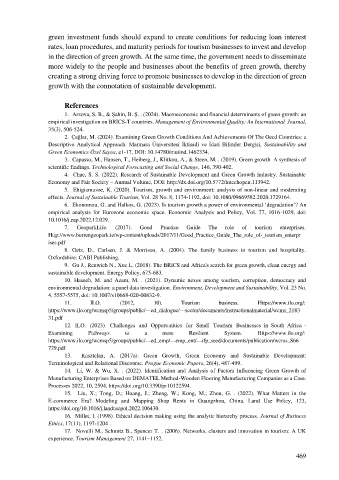Page 477 - Ebook HTKH 2024
P. 477
green investment funds should expand to create conditions for reducing loan interest
rates, loan procedures, and maturity periods for tourism businesses to invest and develop
in the direction of green growth. At the same time, the government needs to disseminate
more widely to the people and businesses about the benefits of green growth, thereby
creating a strong driving force to promote businesses to develop in the direction of green
growth with the connotation of sustainable development.
References
1. Arzova, S. B., & Şahin, B. Ş. . (2024). Macroeconomic and financial determinants of green growth: an
empirical investigation on BRICS-T countries. Management of Environmental Quality: An International Journal,
35(3), 506-524.
2. Çağlar, M. (2024). Examining Green Growth Conditions And Achievements Of The Oecd Countries: a
Descriptive Analytical Approach. Marmara Üniversitesi İktisadi ve İdari Bilimler Dergisi, Sustainability and
Green Economics Özel Sayısı, e1-17, DOI: 10.14780/muiind.1462334.
3. Capasso, M., Hansen, T., Heiberg, J., Klitkou, A., & Steen, M. . (2019). Green growth–A synthesis of
scientific findings. Technological Forecasting and Social Change, 146, 390-402.
4. Chae, S. S. (2022). Research of Sustainable Development and Green Growth Industry. Sustainable
Economy and Fair Society – Annual Volume, DOI: http://dx.doi.org/10.5772/intechopen.113942.
5. Ehigiamusoe, K. (2020). Tourism, growth and environment: analysis of non-linear and moderating
effects. Journal of Sustainable Tourism, Vol. 28 No. 8, 1174-1192, doi: 10.1080/09669582.2020.1729164.
6. Ekonomou, G. and Halkos, G. (2023). Is tourism growth a power of environmental ‘degradation’? An
empirical analysis for Eurozone economic space. Economic Analysis and Policy, Vol. 77, 1016-1029, doi:
10.1016/j.eap.2022.12.029.
7. GeoparkLife. (2017). Good Practice Guide The role of tourism enterprises.
Http://www.burrengeopark.ie/wp-content/uploads/2017/11/Good_Practice_Guide_The_role_of-_tourism_enterpr
ises.pdf
8. Getz, D., Carlsen, J. & Morrison, A. (2004). The family business in tourism and hospitality.
Oxfordshire: CABI Publishing.
9. Gu J., Renwich N., Xue L. (2018). The BRICS and Africa's search for green growth, clean energy and
sustainable development. Energy Policy, 675-683.
10. Haseeb, M. and Azam, M. . (2021). Dynamic nexus among tourism, corruption, democracy and
environmental degradation: a panel data investigation. Environment, Development and Sustainability, Vol. 23 No.
4, 5557-5575, doi: 10.1007/s10668-020-00832-9.
11. ILO. (2012, 10). Tourism business. Https://www.ilo.org/:
https://www.ilo.org/wcmsp5/groups/public/---ed_dialogue/---sector/documents/instructionalmaterial/wcms_2183
31.pdf
12. ILO. (2023). Challenges and Opportunities for Small Tourism Businesses in South Africa -
Examining Pathways to a more Resilient System. Https://www.ilo.org/:
https://www.ilo.org/wcmsp5/groups/public/---ed_emp/---emp_ent/---ifp_seed/documents/publication/wcms_866
729.pdf
13. Kasztelan, A. (2017a). Green Growth, Green Economy and Sustainable Development:
Terminological and Relational Discourse. Prague Economic Papers, 26(4), 487-499.
14. Li, W. & Wu, X. . (2022). Identification and Analysis of Factors Influencing Green Growth of
Manufacturing Enterprises Based on DEMATEL Method-Wooden Flooring Manufacturing Companies as a Case.
Processes 2022, 10, 2594, https://doi.org/10.3390/pr10122594.
15. Liu, X.; Tong, D.; Huang, J.; Zheng, W.; Kong, M.; Zhou, G. . (2022). What Matters in the
E-commerce Era? Modeling and Mapping Shop Rents in Guangzhou, China. Land Use Policy, 123,
https://doi.org/10.1016/j.landusepol.2022.106430.
16. Millet, I. (1998). Ethical decision making using the analytic hierarchy process. Journal of Business
Ethics, 17(11), 1197-1204 .
17. Novelli M., Schmitz B., Spencer T. . (2006). Networks, clusters and innovation in tourism: A UK
experience. Tourism Management 27, 1141–1152.
469

